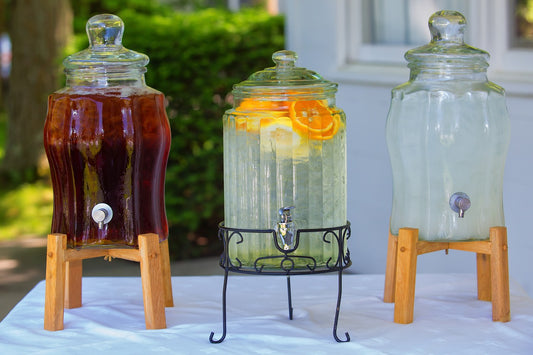Globally there has been a movement towards healthy living and maintaining a healthy lifestyle. More and more people more towards ‘natural’ and ‘clean’ foods. One of the main focuses of the healthy lifestyle movement is reducing sugar intake. One of the easiest ways to do that is to make use of alternative sweeteners. Luckily, we have taken the guess work out of choosing the best alternative sweetener for you and your lifestyle!

There are two main categories of alternative sweetener available. Artificial sweeteners and natural sweeteners. Natural sweeteners are derived from natural ingredients, while artificial sweeteners are made. Both types have their uses, and it often comes down to personal preference when choosing a sweetener.
Artificial Sweeteners:

Aspartame
Aspartame is made from two amino acids, which are the building blocks of protein. When we consume foods or drinks containing Aspartame the sweetener is broken down to its component parts, which are treated in the same way as if they had come from meat, milk, or vegetables. Aspartame brings nothing new to the diet. Its safety has been re-confirmed many times by the European Food safety Authority (EFSA).
Aspartame uses:
Aspartame is most used in both hot and cold beverages, it can also be used on cereals and other breakfast foods like yogurt. Aspartame is not generally used in cooking and baking as heating it for prolonged periods can cause it to lose its sweetness. The original Canderel range contains aspartame and is most widely used to sweeten beverages. This range includes both the tablets and sticks for your convenience.
Acceptable Daily Intake (ADI):
The ADI set for Aspartame by the Food and Agriculture Organization/World Health Organization (FAO/WHO) Joint Expert Committee on Food Additives, is 40 mg/kg of body weight per day. An adult weighing 70kg can safely consume 184 Canderel® original tablets a day for their whole life.

Sucralose:
Sucralose is a non-calorie sweetener made from sugar. It’s 600 times sweeter than sugar and has a clean, sweet taste without an aftertaste. Sucralose can be used in place of sugar in many foods and beverages. It also works well in most home cooking and baking recipes.
Made from:
Sucralose is produced from sugar through a multistep manufacturing process. During this process a small amount of chlorine is added which changes the structure of the sugar molecule. This change produces a sweetener that has no calories but is 600 times sweeter than sugar. There is no cause for concern about the safety of sucralose due to the presence of chlorine. Chlorine is present naturally in many foods and beverages that we eat and drink every day. For example, lettuce, mushrooms, and table salt contain small amounts of chlorine.
Sucralose uses:
Just like aspartame, sucralose can be used to sweeten beverages and cereals. Granular sucralose can be used in baking because unlike aspartame, sucralose is heat stable. Canderel has a Sucralose range of both tablets and sticks perfect for any occasion!
Acceptable Daily Intake (ADI):
The ADI set for Sucralose by the Food and Agriculture Organization/World Health Organization (FAO/WHO) Joint Expert Committee on Food Additives, is 15 mg/kg of body weight per day. For an adult weighing 70 kg can safety consume 170 teaspoons of Ideal for baking granular a day for the whole life.
Natural Sweeteners:

Stevia:
Natural derived from Stevia Plant. It's about 100 to 300 times sweeter than table sugar, but it has no carbohydrates, calories, or artificial ingredients. Not everyone likes the way it tastes. Some people find it bitter, but others think stevia tastes like menthol. Try it in your morning coffee or sprinkled over your oatmeal to see if you like the taste.
Stevia uses:
Stevia can be used to sweeten both hot and cold drinks, it is perfect for cereal and cooking. Just check the product package for a sugar to stevia ratio. One Canderel Stevia stick is equal to one teaspoon of sugar. Unfortunately, stevia is not ideal for baking as it doesn’t have the same properties of sugar.
Acceptable Daily Intake (ADI):
Experts agree that stevia is safe for everyone, including children, pregnant or lactating individuals, people with diabetes, and overweight individuals. The ADI for stevia set by regulatory authorities is 4 mg of steviol equivalents per kilogram of body weight. This means that a 70 kg individual would need to eat approximately 30 – 40 packets of stevia sweetener per day for the rest of their life to reach the ADI.

Xylitol:
Xylitol is a natural sugar alcohol found in plants, including many fruits and vegetables. It has a sweet taste and is often used as a sugar substitute.
Xylitol tastes sweet but, unlike sugar, it doesn't cause tooth decay. It reduces levels of decay-causing bacteria in saliva. It's widely used in "sugar-free" chewing gums, mints, and other candies.
Xylitol uses:
Xylitol can easily be used in baking and cooking as well as sweetening beverages and cereals. It is particularly good in cakes and other baking. It is important to note that xylitol will not melt down into a liquid form or caramelize, even if it is heated at an extremely high temperature for a long period of time.
Armed with all this knowledge, you can now make smart and informed decisions on which sweetener would best fit your lifestyle, taste, and health goals!




